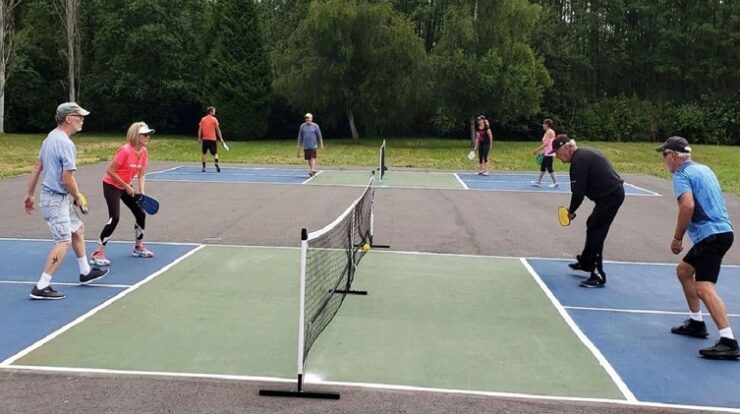
Introduction
Serving in pickleball doubles is the opening act of every point, a crucial moment that sets the tone for the game. The serving sequence is not just about getting the ball in play; it’s about strategizing and working as a team to gain an advantage. In this comprehensive guide, we will explore the intricacies of the serving sequence in pickleball doubles, covering the rules, strategies, and tactics that can make the difference between a winning serve and a missed opportunity.
The Basics of Serving in Pickleball Doubles
Before diving into the strategic aspects of the serving sequence in pickleball doubles, it’s essential to understand the fundamental rules
Service Court
In doubles, there are two service courts: the right-hand service court and the left-hand service court. The server must stand behind the baseline and diagonally opposite to the service-receiving player.
Diagonal Rule
The serve must be directed diagonally across the court. If you’re in the right service court, you serve to the opponent’s right service court, and vice versa.
Faults
Common faults include stepping on or beyond the baseline during the serve, failing to make a proper underhand serve, or serving to the wrong service court.
Double Bounce Rule The served ball must first bounce in the receiving team’s service court. The return must also bounce once in the serving team’s court. After these two bounces, volleys become legal.
Team Dynamics in Serving
One of the unique aspects of pickleball doubles is that you’re not serving as an individual; you’re serving as a team. This means that you and your partner should work together to maximize your serving advantage:
Serve Selection
Decide on a serving strategy with your partner. Will you serve hard and deep to push opponents to the baseline, or will you opt for a soft, short serve to keep them at the non-volley zone? Communication is key.
Positioning
The server’s partner should position themselves optimally at the non-volley zone, ready to anticipate and react to the opponent’s return. Being in the right position can help you dominate the net.
Covering the Court
Your serving strategy should also include anticipating where the return is likely to go. This allows your partner to be in position to cover the court effectively.
Serve and Volley
In some cases, it can be effective to follow a strong serve to the net, ready to volley the opponent’s return. However, this should be done judiciously, as it can expose vulnerabilities.
Strategic Serving Techniques
Developing a successful serving sequence in pickleball doubles requires a variety of serving techniques and strategies. Here are a few to consider:
Deep Serve
A deep serve that lands near the baseline can put pressure on your opponents, pushing them back and making it difficult for them to attack the net.
Short Serve
A short serve, landing just over the net and close to the non-volley zone, can force opponents to hit up, providing an opportunity for your team to take control of the net
Angle Serve
Using the diagonal rule to your advantage, angle your serves to exploit your opponent’s weaknesses. If your opponents have weaker backhand shots, for example, aim your serve to their backhand side.
Read More: James P Devellis – 3 Key Sports Injuries Which Affect Athletes
Spin Serves
Develop the ability to add topspin or backspin to your serves. Spin can make the ball dip or bounce unpredictably, making it challenging for opponents to return.
Change of Pace
Vary your serve speed. Combining fast and slow serves can disrupt your opponent’s rhythm and keep them guessing.
Surprise Element
Don’t be afraid to throw in a surprise serve occasionally, like an unexpected lob serve. It can catch your opponents off guard.
Scoring Points Through Serving
Serving isn’t just about starting the point; it’s also an opportunity to score points. Winning points on your serve is a significant advantage, and there are strategies to achieve this:
Placement
Aim for the weaker player on the opposing team. If you can consistently target their vulnerabilities, you’ll increase your chances of winning points on your serve.
Forcing Errors
Apply pressure with a strong serve or a well-placed shot. Force your opponents into making mistakes, like hitting the ball out of bounds or into the net.
Control the Net
Use your serving sequence to set your team up for a successful net game. If your opponents return weakly, your team can take control of the non-volley zone and dominate the point.
Vary Your Serves
Keep your opponents guessing by mixing up your serves. This prevents them from getting comfortable and predicting your next move.
Conclusion
Mastering the serving sequence in pickleball doubles is a journey that combines rules, communication, teamwork, and strategic thinking. A well-planned serving strategy can give your team a significant advantage and set the stage for success in each match. As you practice and refine your serving skills, remember that flexibility and adaptability are key. The ability to adjust your strategy based on your opponents’ strengths and weaknesses will make you a formidable doubles team on the pickleball court. So, get out there, serve with precision and strategy, and watch your pickleball doubles game reach new heights.
